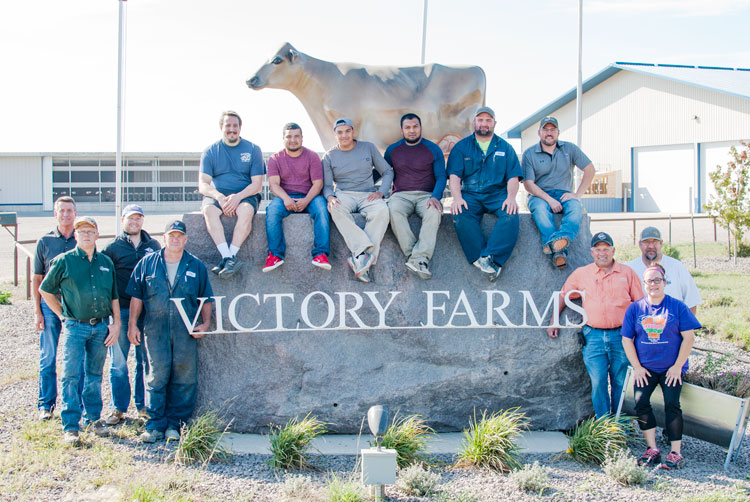
“We record breeding codes on all breedings so we can track performance,” explained general manager Kevin Souza of Victory Farms in Milbank, S.D. “We record all heats, breedings, and health events on Dairy Comp 305,” explained the first-year Platinum winner of the 11th annual Dairy Cattle Reproduction Council’s (DCRC) annual awards competition. It’s so important that Kevin Souza enters most of the data himself.
All six of this year’s Platinum winners of the Dairy Cattle Reproduction Council’s awards share additional insight in this Hoard’s Dairyman Intel as well as the Round Table found on pages 679 to 682 of the November issue of Hoard’s Dairyman. This year’s competition drew the second-largest set of nominations to date — 102 — from 15 U.S. states and seven countries found on four continents.
Here are additional responses to the question, “How do you keep track of records?”
Holmesville Dairy, Argyle, Wis.: Our Genex technician does all the record keeping for the A.I. work and enters data into our Dairy Comp 305 software. All herd health results are entered by the herdsman. The Dairy Comp 305 program outputs protocol lists for ovsynch along with breeding records for the breeder to have with him while walking the cows.
Pendora Dairy, Monkton, Ontario, Canada: Records give indicators to solve problems for our nutrition and veterinary team. All events get recorded in our Afi system. This includes vaccinations, breedings, early embryonic death, abortions, calvings, retained placentas (RPs), milk fevers, ketosis, and other health events. If there is a problem cow, you have a history to evaluate.
Rick, Ingrid, and Jesse record data in Afi, as they are the only ones to treat or breed the animals. All other employees communicate via text or the whiteboard with management staff on all other cow events, which are dealt with and recorded accordingly.
Rollin’ Green Dairy, Brooklyn, Wis.: We utilize Dairy Comp Scout for our record keeping. This allows us to keep track of technician, sire code, breeding code, and so forth. We also keep a paper log that is used by both the A.I. technicians and Jeff. This gives us a second record to refer back to if there are ever any questions on a breeding.
As far as observing heats, the 21-day interval list is printed every Monday for the middle of the week. Those cows are tail painted, and that list is kept in my (Jeffrey) pocket all week. It is in my hand while walking cows three times a day and is a constant reminder to be watching those cows. The list is scribbled on with any notes about potential signs of heat that include bawling, discharge, scuffed up tail heads, sniffing, and so forth.
When painting cows weekly, we rotate the color of tail paint every week. This also helps point out what cows to be watching. By keeping good records, it provides good data as to what to do for the next breeding. It also gives us data to calculate success rates for every method.
We always look up the cow before breeding on a standing heat as to what its status is. We look at whether it is at the right interval and if it has been bred to multiple standing heats. If a cow is bred twice without being checked by the vet, she is usually flagged for vet check after breeding just to make sure it is cycling okay. GnRH is given at every standing heat breeding.
Good record keeping and overall organizational skills help us follow through with proper protocols and procedures. Another random thing I do, somewhat related to record keeping, is throughout both morning and night milkings I make a “things to do” list for after milking. This can be anything from certain ovsynch protocols, to dry cows, to recheck a cow with a high milk temperature, and cow treatments. I’ve found this very helpful for when I get out to the barn to perform herdsman duties and so I don’t forget anything.
Schilling Farms, Darlington, Wis.: All reproductive data is recorded on the Dairy Comp 305 herd management software. Heats and breedings are entered by the breeders. Brian records herd health data and ovsynch shots. Dairy Comp 305 also generates reproductive protocol and herd checklists.
Seidl’s Mountain View Dairy, Luxemburg, Wis.: All information is entered by the herd manager using Dairy Comp 305. We record all fresh dates, dry dates, pen moves, breeding dates, and all health records. We also rely on Dairy Comp 305 to get all reports for herd checks, reproductive therapy, and vaccination. We also consult Dairy Comp 305 records to monitor production levels when making breeding decisions.
This Hoard’s Dairyman Intel article is part of a seven-part series detailing top reproduction tips from the Platinum winning herds for the 11th annual Dairy Cattle Reproduction Council awards competition.
Click below to view previous reports from this DCRC series:
He checks for heats morning, noon, and night
Our presynch protocol sets the stage
Breeding cows has become a friendly competition
One feeder helps keeps rations consistent








